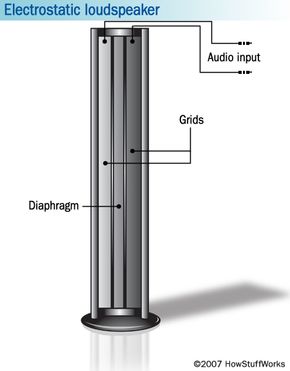Electrostatic and Dynamic Transducers
To hear what's recorded on a record, cassette, CD, DVD or MP3 player, data stored on the medium must be converted into sound waves. This requires that the stored information be turned into an electrical signal, which then must pass through a transducer to convert the transverse electrical wave into a longitudinal sound wave that the ear can interpret. Speakers play the role of transducers in audio systems. They can be located far away from the listener's ear, however.
Headphones were developed specifically to solve this problem. Headphones are essentially speakers held over the ear by a band or wire worn on the head. They are categorized by the type of transducer technology use and by their construction. Let's look first at electrostatic headphones.
Advertisement
Electrostatic Headphones
Electrostatic headphones take advantage of a phenomenon that most people know as static electricity. When an object becomes charged, it either gains or loses electrons. An object that gains electrons is negatively charged; an object that loses electrons is positively charged. Objects with like charge experience repulsive forces, while oppositely-charged object experience attraction. These forces are known as electrostatic forces.
To create these forces in electrostatic headphones, a thin diaphragm -- a flexible sheet made of paper, plastic or metal -- is suspended between two metal grids or electrodes. When an audio signal is applied, varying attractions are created along the grids. This pushes part of the diaphragm toward one grid and pulls part toward the opposing grid. The resulting vibrations in the diaphragm produce the sound waves that are eventually detected by the ear.
Dynamic Headphones
Electrodynamic (or dynamic, for short) headphones are made of three functional parts -- a voice coil, a permanent magnet and a cone-like diaphragm. The narrow end of the cone is attached to the voice coil and actually generates the sound waves. It does this by vibrating rapidly in response to the vibrating voice coil, much the same way the three bones of the ear vibrate in response to the movement of the eardrum.
The vibration of the voice coil is made possible by two fundamental properties of magnetism:
- Identical magnetic poles repel each other, while opposite poles attract
- Electric current flowing through a coil of wire produces a magnetic field, with the direction of current flow determining the polarity of the magnetic field
When a voice coil is placed within the unchanging magnetic field of a permanent magnet, these two properties are realized. Switching the electrical signal that is pumped into the coil causes the North and South poles to switch back and forth very rapidly. As the North and South poles of the voice coil's magnetic field switch, they are attracted and then repelled as they interact with the permanent magnet. Because the permanent magnet is fixed and the voice coil isn't, the latter vibrates and transmits these vibrations to the diaphragm.
We'll look at some common dynamic headphone styles in the next section.
